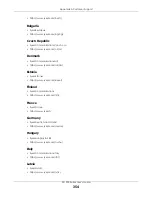
XS1930 Series User’s Guide
339
C
HAPTER
47
IPv6 Neighbor Table
47.1 IPv6 Neighbor Table Overview
This chapter introduces the IPv6 neighbor table.
An IPv6 host is required to have a neighbor table. If there is an address to be resolved or verified, the
Switch sends out a neighbor solicitation message. When the Switch receives a neighbor advertisement
in response, it stores the neighbor’s link-layer address in the neighbor table. You can also manually
create a static IPv6 neighbor entry using the
Basic Setting > IPv6 > IPv6 Configuration > IPv6 Neighbor
Setup
screen.
When the Switch needs to send a packet, it first consults other table to determine the next hop. Once
the next hop IPv6 address is known, the Switch looks into the neighbor table to get the link-layer address
and sends the packet when the neighbor is reachable. If the Switch cannot find an entry in the
neighbor table or the state for the neighbor is not reachable, it starts the address resolution process. This
helps reduce the number of IPv6 solicitation and advertisement messages.
47.2 Viewing the IPv6 Neighbor Table
Use this screen to view IPv6 neighbor information on the Switch. Click
Management
>
IPv6
Neighbor
Table
in the navigation panel to display the screen as shown.
Figure 251
Management > IPv6 Neighbor Table
The following table describes the labels in this screen.
Table 179 Management > IPv6 Neighbor Table
LABEL
DESCRIPTION
Sort by
Select this to display and arrange the data according to IPv6 address (
Address
), MAC address
(
MAC
) or IPv6 interface (
Interface
). The information is then displayed in the summary table below.
Index
This field displays the index number of each entry in the table.
Address
This field displays the IPv6 address of the Switch or a neighboring device.
MAC
This field displays the MAC address of the IPv6 interface on which the IPv6 address is configured or
the MAC address of the neighboring device.
















































